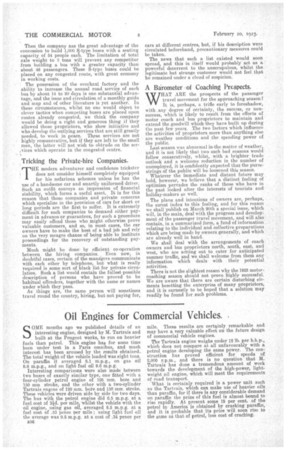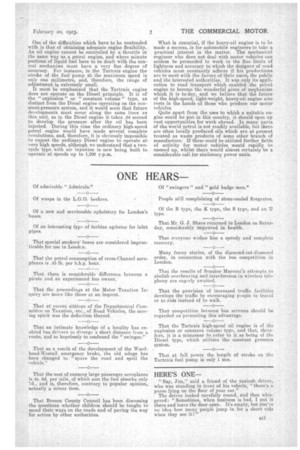Oil 'Engines for Commercial Vehicles. .
Page 2

Page 3

If you've noticed an error in this article please click here to report it so we can fix it.
SOME months ago we published details of an interesting engine, designed by M. Tartrais and built at the Peugeot works, to run on heavier fuels than petrol. This engine has for some time been under test in a Paris omnibus, and much interest has been aroused by the results obtained. The total weight of the vehicle loaded was eight tons. On paraffin it averaged 8.1 m.p.g., on gas oil 8.6 m.p.g.1 and on light fuel oil 9.6 m.p.g.
Interesting comparisons were also made between two buses of exactly similar type, one fitted with a four-cylinder petrol engine of 105 mm. bore and 150 mm stroke, and the other with a two-cylinder Tartrais engine of 120 mm. bore and 150 mm. stroke. These vehicles were driven side by side for two days. The bus with the petrol engine did 6.5 m.p.g. at a fuel cost of 3id. per mile, whilst the vehicle with the oil engine, using gas oil, averaged 8.5 m.p.g. at a fuel cost of .53 pence per mile ; using light fuel oil the average was 9.5 m.p.g. at a cost of .34 pence per B}6 mile. These results are certeinly remarkable and may have a very valuable effect on the future design of commercial vehicle engines.
The Tartrais engine weighs under 12 lb. per b.h.p., which does not compare at all unfavourably with a petrol engine developing the same power. The construction has proved efficient for speeds of 2,000 r.p.m., and there is no question that M. Tal-trais has dorm a tremendous amount of work towards the development of the high-power, lightweight oil engine, which will meet the requirements of road transport. What is certainly required is a power unit such as the Tartrais, which can make use of heavier oils than paraffin, for if there is any considerable demand on paraffin the prize of this fuel is almost bound to rise rapidly. At present some 15 per cent, of the petrol in America is obtained by cracking paraffin, and it, is probable that its price will soon rise to the same as that of petrol, less cost of cracking. One of the difficulties which have to be contended with is that of obtaining adequate engine flexibility. An oil engine cannot be controlled by a throttle in the same way as a petrol engine, and where minute portions of liquid fuel have to be dealt with the control mechanism must have a very fine degree of accuracy. For instance, in the Tartrais engine the stroke of the fuel pump et the maximum speed is only one millimetre, and, therefore, the range of adjustment is extremely small. It must be emphasized that the Tartrais engine does not operate on the Diesel principle. It is of the " explosion " or "constant volume" type, as distinct from the Diesel engine operating on the constant-pressure system, and it would seem that future developments must occur along the same lines as this unit, as in the Diesel engine it takes .04 second to develop the pressure after the oil has been injected. During this time the ordinary high-speed petrol engine would have made several complete revolutions, and, therefore, it is obviously impossible to expect the ordinary Diesel engine to operate at very high speeds, although we understand that a twocycle type with air injection is now being built to operate at speeds up to 1,200 r.p.m. What is essential, if the heavy-oil engine is to be made a success, is for automobile engineers to take a practical interest in the matter. The mechanical engineer who does not deal with motor vehicles can seldom be persuaded to work to the fine limits of lightness and accuracy to which the designer of road vehicles must constantly adhere if his productions arc to meet with the favour of their users, the public and the interested authorities. It was only its application to road transport which enabled the petrol engine to become the wonderful piece of mechanism which it is to-day, and we believe that the future of the high-speed, light-weight, heavy-oil engine also rests in the hands of these who produce our motor vehicles.
Quite apart from the uses to which a suitable engine could be put in this country, it should open up vast opportunities for work abroad. In many parts of the world petrol is not readily available, but there are often locally produced oils which are at present treated as waste products of some other branch of manufacture; If these could be utilized further fields of activity for motor vehicles wourd rapidly be opened up, whilst there would almost certainly be a considerable call for stationary power units.






























